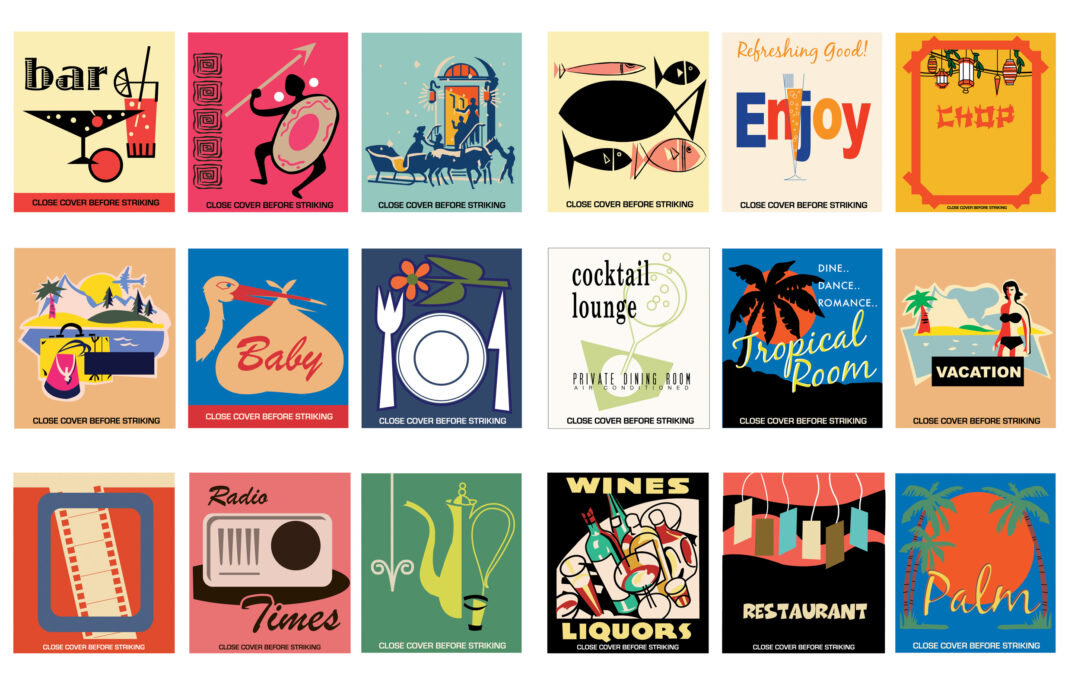The Mind’s Eye
Being stuck at my mom’s house in Western North Carolina during the early days of the stay-at-home order was an experiment in patience and a test of the powers of anti-anxiety medication. But it did give me the opportunity to dig around her house in search of hidden treasure, the kind of stuff I might be able to sell on eBay without her missing it. While prowling around some rusty shelves in the basement, I came across a cardboard box full of matchbooks. I immediately thought of the tremendous fire hazard this posed and how careless it was to store such a tinderbox next to stacks of old magazines, rolls of gift wrap, and a dingy bottle of tiki-torch fuel that was probably purchased sometime during the Reagan administration.
I hauled the box upstairs and dumped the matchbooks onto the dining room table. There were more than 200, and they covered the tabletop like a patchwork quilt. Some of the matchbooks were thin and narrow while others were wide and fat. Many were small rectangular boxes encasing a tiny drawer stuffed with enough wooden matches to get through at least two packs of cigarettes. Each matchbook bore a distinctive logo of a restaurant or hotel. The variety was extraordinary: Le Cirque in New York City and Shoney’s in Waynesville, North Carolina, The Fog City Diner in San Francisco and Crabby Mike’s Unlimited Seafood Buffet in Surfside Beach, South Carolina, The Homestead in Hot Springs, Virginia, and Horne’s Motor Lodge in Ocala, Florida.
Starting in the early 1970s, my parents spent several weeks each year traveling across the country in a succession of increasingly elaborate conversion vans. They were equal-opportunity travelers, exploring Michelin-starred restaurants and luxury hotels as well as hole-in-the-wall dives and roadside motels. And wherever they stopped, my mom would grab a matchbook, a free souvenir back when smoking was cool and a pack of matches was an inexpensive bit of promotional swag.
For my mom, each of the matchbooks represents an experience: a meal, an overnight stay, an escape. When she saw me sorting through the pile, she sat down and picked up a matchbook from the Oyster Bar at Grand Central Station. With her dementia, it’s at times difficult for her to remember the names of her grandkids or the season of the year, but she was able to remember that when he was alive, the Oyster Bar was one of my dad’s favorite restaurants. She recalled the restaurant’s interior: the snaking counters, the red-and-white-checkered tablecloths, the gleaming tiles on the curved ceiling. We spent a couple of hours going through the matchbooks, and I was surprised, and also inspired, by her ability to recall vivid details of places she’d visited decades ago.
I’ve often considered travel to be 15 percent anticipation, 10 percent experience, and 75 percent recollection. Those percentages are comforting at a time when travel is considered dangerous. So until the bans are lifted and the allure of travel outweighs the fear of illness, I’ll escape the way my mom does, through memory. I’ll dig around for my own hidden treasures: post cards, ticket stubs, train schedules, paper maps—the scraps of travel ephemera I’ve collected over the years. Like my mom’s matchbooks, these little souvenirs have the power to transport me to places far from the here and now. It’s a much-needed escape and a bit of freedom during an anxious period of confinement.
Published in TOWN magazine.

